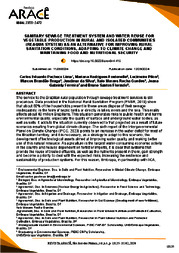Sanitary sewage treatment system and water reuse for vegetable production in rural and isolated communities (Reaqua system) as an alternative for improving rural sanitation conditions, adapting to climate change and maintaining food and nutritional security.
Sanitary sewage treatment system and water reuse for vegetable production in rural and isolated communities (Reaqua system) as an alternative for improving rural sanitation conditions, adapting to climate change and maintaining food and nutritional security.
Autoria: LIMA, C. E. P.; FONTENELLE, M. R.; PILON, L.; BRAGA, M. B.; SILVA, J. da; GUEDES, I. M. R.; FERREIRA, J. G.; FLORINDO, B. S.
Resumo: The service to the Brazilian rural population through sewage treatment services is still precarious. Data provided in the National Rural Sanitation Program (PNSR, 2019) show that about 80% of the households present in these areas dispose of their sewage inadequately, in the form of septic tanks or directly in lakes, rivers and the sea. This reality affects about 40 million Brazilians. This situation generates risks to public health and harms environmental quality, especially the quality of surface and underground water bodies, as well as soils. It adds to the situation currently observed to that projected as a result of future scenarios resulting from global climate change. The sixth report of the Intergovernmental Panel on Climate Change (IPCC. 2023) points to an increase in the water deficit for most of the Brazilian territory, and it is necessary, as a strategy to adapt to this scenario, the development of technological assets aimed at improving water quality and making better use of this natural resource. As agriculture is the largest water-consuming economic activity in the country and heavily dependent on fertilizer imports, it is clear that systems that provide the reuse of treated effluents, as well as the nutrients present in them, gain strength and become a priority to deal with the expected risks, increasing the resilience and sustainability of production systems. For this reason, Embrapa, in partnership with IICA,low-cost alternative, easy installation and operation, low energy and labor dependence, and high efficiency in the removal of organic load and pathogens to serve rural and isolated communities. The ReAqua System consists of two stages, the first consisting of the Sewage Treatment Plant (ETE) and the second the agricultural system for the production of vegetables. The WWTP is assembled using tanks and water tanks, PVC or fiberglass pipes and connections, as well as materials used for civil construction. The sewage treatment system is based on joint Septic Tank – Anaerobic Filter, followed by sequential slow filtration with increasing difficulty and chlorine disinfection. The agricultural system stage of vegetable production is based on the use of gravity irrigation, reuse of nutrients by fertigation, use of soil cover by mulching The quality of the reused water, as well as the agricultural management used, allows the safe production of vegetables with less dependence on mineral fertilizers.
Ano de publicação: 2024
Tipo de publicação: Artigo de periódico
Unidade: Embrapa Hortaliças
Palavras-chave: Mudança Climática, ODS 6, Saneamento Rural, Tratamento de Esgoto, Água
Observações
1 - Por padrão são exibidas publicações dos últimos 20 anos. Para encontrar publicações mais antigas, configure o filtro ano de publicação, colocando o ano a partir do qual você deseja encontrar publicações. O filtro está na coluna da esquerda na busca acima.
2 - Para ler algumas publicações da Embrapa (apenas as que estão em formato ePub), é necessário ter, no celular ou computador, um desses softwares gratuitos. Sistemas Android: Google Play Livros; IOS: iBooks; Windows e Linux: software Calibre.
Acesse outras publicações
Acesse a Base de Dados da Pesquisa Agropecuária (BDPA) para consultar o acervo completo das bibliotecas da Embrapa.

